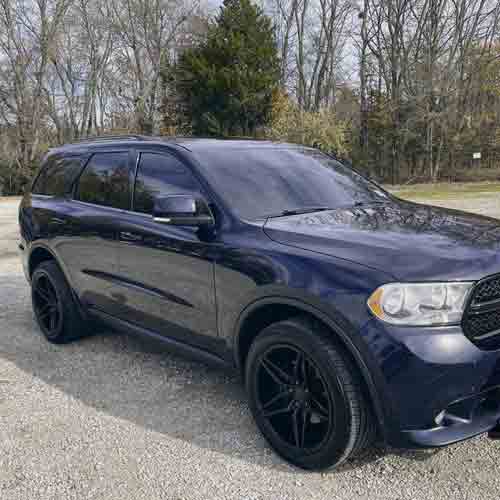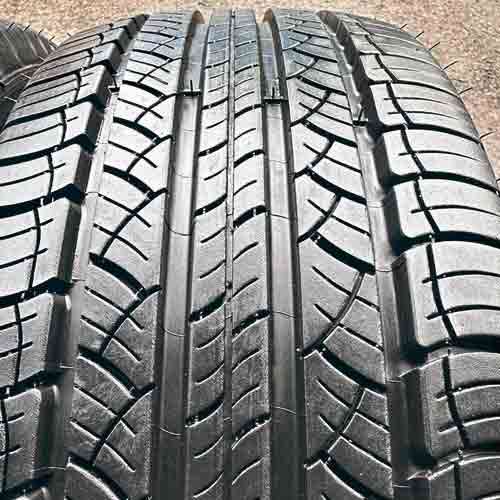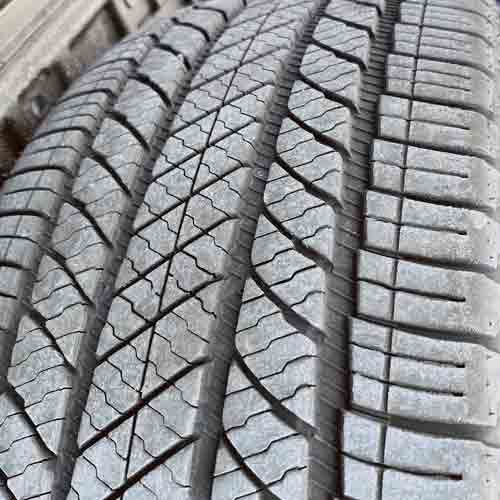Both the Michelin Latitude Tour HP and the Bridgestone Alenza AS Ultra are part of the SUV Touring All-Season category, tailored for drivers of crossovers, SUVs, and pickup trucks aiming for a comfortable and confident all-season driving experience. Let’s find a better fitting tire here, for your needs.

Main Highlights
So overall, the Michelin Latitude Tour HP is better at:
- Dry-Road Braking: Demonstrating superior stopping power with its continuous central ribs and enhanced grip.
- Overall Handling: Providing better lateral grip and steering responsiveness due to its stiffer rubber composition and internal construction.
- Handling Road Vibrations: Offering a smoother ride by effectively managing smaller road imperfections.
Review this tire in greater details: https://tiredriver.com/michelin-latitude-tour-hp-review/
On the flip side, the Bridgestone Alenza AS Ultra takes the lead in:
- Wet-Road Performance: Excelling in wet traction and hydroplaning resistance with its denser siping and interconnected grooves.
- Performance on Ice: Outperforming in icy conditions with its advanced siping and groove design for better grip.
- Noise Reduction and Comfort: Providing a quieter and more comfortable ride with QUIETTRACK technology and a more flexible structure.
Review this tire in greater details: https://tiredriver.com/bridgestone-alenza-as-ultra-review/
Tread Features
The Michelin Latitude Tour HP rolls out with a symmetric tread design, flaunting five ribs.

Now, here, while these ribs share some similarities in their tread features, there are subtle but important differences as well.
Take the central rib, for instance…
It runs continuously with offset edges, creating robust circumferential grooves on both sides.
And the ribs next to it feature interlinked in-groove notches, cleverly connecting the outer longitudinal channels.
Moving towards shoulders, here lugs are interconnected with each other longitudinally, by ridges.
And all blocks carry curved lateral and longitudinal slits, which act as sipes for wet traction, and biters on dry roads.
An yes, worth reminding, all of the these ribs (including the central one), have reinforced foundations underneath. They are actually sitting on a relatively harder secondary rubber layer, adding to the tire’s stability and handling.
Moving towards, the Alenza AS Ultra, this tire also features a similar 5 rib symmetric tread pattern, though its relatively more “open”, or spacious.

It’s central most rib comes with a very wide structure, where blocks features chamfered edges, and a lot of wave-like siping.
Moreover, there’s also a longitudinal slit dividing the rib in half.
The adjacent ribs are relatively more spacious, and come with thicker lateral voids, with off-set edges.
Together all these 3 ribs (in the middle) form 4 circumferential channels, which have a pattern on their own.
This secondary tread pattern (sitting on the base), basically improves the tire’s noise dampening abilities.
Lastly, the outer shoulder blocks are pretty straightforward. They form curved lateral voids and are equipped with linear sipes running horizontally and vertically, ensuring a stable and smooth ride.
A little tip from me to you: My main all-season tire page is the starting line for your tire-shopping success. At least that’s what my regular site visitors say.
Info on Sizes
The Bridgestone Alenza AS Ultra comes in 16 to 21 inches rims, with total of 49 sizes having following specs.
- Speed ratings: H, V and W.
- Load ratings: SL, XL.
- Weight range: 24 to 42 lbs.
- Tread depth: 10/32″ (or 8mm) on all.
- UTQG: 680 A A.
- Treadwear warranty: 80k miles.
- Internally, the tire comes with 2 ply polyester, 2 steel belts, with single nylon cap ply on top.
The Michelin Latitude Tour HP comes in 16 to 22 inches rims, and they have the following specs.
- Speed ratings: H, V, W, and Y.
- Load ratings: SL and XL.
- Tread depth range: 9 to 10/32″.
- Weight range: 27 to 43 lbs.
- Treadwear warranty: 55k miles for H and V rated sizes, and 45k for W, and Y speed rated ones.
- UTQG rating: 440 A B.
- Internally, the tire comes with a single-ply polyester casing, flanked by two steel belts and a nylon cap ply.
Wear Resistance
For a tire to excel in tread lifespan, it needs a combination of durable construction and advanced design features. Stiffer rubber is often used in such tires to resist wear while providing consistent grip in various conditions.
And here’s where the Alenza stands out notably, which is not a surprise, since it offers a 80k miles treadwear warranty.
So what makes this tire better? Well this is mainly because of its relatively lighter structure, (even though it features more plies in its internal construction).
This lighter weight means less pressure is exerted on the tire lugs during road contact, which helps in extending the tire’s tread life.
On the other hand, the Michelin Latitude Tour “HP”, being a high-performance SUV grand touring tire, although offers greater grip, it comes at the cost of greater rolling resistance, which not only lowers down its tread longevity but also fuel economy.
For Your Info: For those interested in Michelin’s offerings, it’s worth looking at the standard Michelin Latitude Tour, not the “HP” version. Despite a similar appearance, the simpler version provides a longer tread life and comes with a 65,000-mile warranty. In contrast, the HP variant’s warranty varies between 45,000 to 55,000 miles, depending on speed ratings.
A side note here, I covered a lot of useful stuff in: Do all-season tires wear out faster?
Dry-Road Performance
Understanding the tire’s traction and steering response in dry conditions offers a complete insight. Therefore, examining each aspect independently is crucial.
Linear Grip
Linear grip measures a tire’s ability to maintain friction with the road during straight-line movements, like driving on highways.
It’s all about how well the tire can stop, and it depends a lot on tread’s central region, as this part bears most of the vehicle’s weight when rolling straight.
Now comparing both boys here, the Michelin stands out with its superior braking performance, where the tire stopped 2 feet quicker in my conducted braking distance tests, on average.
The reason? Well, the Latitude Tour HP features continuous central ribs with a more solid reinforced foundational supports, relatively.
That’s why these ribs not only ensure consistent contact with the road but also provide excellent on-center feel, which is basically the sense of responsiveness and stability when you’re bringing the steering wheel back to neutral after a turn.
In contrast, the Alenza AS Ultra, with its more voided structure, doesn’t quite match up, in both these areas, where the tire’s greater weight is also a culprit (besides it not providing ample contact patch).
Simply put, greater weight generates greater momentum, which necessitates greater force/energy to stop.
Overall Handling
The overall handling of a tire is determined by a mix of its directional grip, lateral traction, and steering response. And in this regard, the Latitude Tour HP emerges as a frontrunner.
As we’ve already discussed, this tire excels in directional grip, enabling it to both enter and exit corners more quickly.
Moreover, Michelin offers superior lateral grip as well, (confirmed by lateral g-force measurements), and with it, its able to provide you with better mid-cornering feedback in comparison too.
This enhanced stability of the tire stems from its internally housed spirally-wound nylon cords, and a relatively stiffer rubber composition.
And yes, its also contributed by its tread sitting on a secondary rubber layer beneath, providing reinforced foundations to lugs.
All these tread elements allow this tire to achieve some of the quickest dry lap times in its category, as demonstrated in tests.
On the other side, the Bridgestone Alenza AS Ultra again lacks due to its greater weight, and less effective lug foundations, causing them to bend more.
And with lugs flexing a bit more, they take greater time to return to their original shapes, and that time gets reflected in to the delay you get between the steering inputs and outputs, lowering overall handling responsiveness.
Ride Quality
For me, a tire’s contribution to a smooth ride is primarily based on its stability, ability to smooth out road imperfections, and noise dampening capability. Let’s break this down into two distinct sections for clarity.
Though I’d recommend checking out this first: Are All-Season Tires Comfortable And Quiet Enough?
Noise Dampening
In terms of noise, you get a better performance on Alenza. This is because the Michelin Latitude HP’s tread generates a lot of in-groove resonance.
Michelin’s design basically causes sound to echo (a lot more), within the tread, when air hits the tread walls, amplifying the noise generated during driving.
Whereas the Bridgestone AS Ultra provides you with QUIETTRACK technology to deal with this.
This technology involves a specialized tread design that alters the way air interacts with the tire, effectively reducing noise through sound cancellation.
And yes it also include the combination of innovative tread design and sound-absorbing materials. So the in-groove resonance is also kept to a minimum.
Vibrations Comfort
The comfort level of a tire’s ride is of course also greatly influenced by how well it handles road irregularities. And in this aspect, the Latitude Tour HP could use some improvements.
Its robust structure, featuring a hard nylon cap ply with a spirally wound design although provides decent stability, its not so effective in reducing road vibrations.
The tire although does a good job at smoothing out smaller bumps, it reaches out its flexibility limit sooner, with larger ones, which are more noticeably transmitted to the vehicle’s cabin.
Conversely, the Bridgestone Alenza AS Ultra takes the upper hand in ride comfort with its more flexible structure. Basically it has lugs with more prominent gaps in between, this allows them to flex, absorbing in the energy form the road imperfections.
Additionally, you also get one extra polyester ply in its internal construction, and greater tread depth (on average). Both of these design elements add to the tire’s cushioning properties further, contributing to a smoother and more comfortable ride.
Winter Traction
In evaluating the winter performance of all-season tires, we concentrate on three crucial aspects:
- Acceleration and braking.
- Handling: This includes the tire’s steering response in winter conditions.
- Performance on Different Terrains, where attention is given to how the tire behaves on soft snow and ice.
Now here, you get some mixed results, where the Latitude Tour HP outperforms on snow, while the Alenza AS Ultra shows better results on icier surfaces.
The Michelin Tour, although lacks in providing adequate wet traction, it still provides you with superior snow grip and traction. This is because its sipes are more “winter-focused”, with their thicker slits.
Basically with thicker slits, the tire is able to effectively capture-in snow particles in them, providing snow to snow contact.
Now, if you don’t know, this contact is pretty necessary, as snow adheres better to itself, offering a stronger grip compared to snow-to-rubber contact.
On the other hand, the Bridgestone Alenza AS Ultra stands out for its ice traction. as its tread is equipped with an abundance of interlocking sipes, which are distributed throughout and have a multi-directional orientation.
This design allows the tire to micro-grip the icy surface, from various angles, enhancing its ice traction.
Side Note: If snow traction is important to you, you should considering looking at How To Improve Snow Performance From All-Season Tires?
Wet-Road Performance
For wet conditions, the focus is on two things: grip and preventing hydroplaning.
Let’s investigate these factors thoroughly.
Wet Grip and Handling
Wet traction is all about getting rid of water from the tread effectively, which is vital because water can’t be compressed.
Meaning, if it’s not removed quickly enough, it would come in between, causing tires to slip, or worse, hydroplane (discussed below, under separate heading).
Now, grooves do most of this water expulsion, but there’s often some water left behind by them, coming underneath the lugs.
This is where sipes, those tiny slits in the tire, become important. They act like little vacuums, sucking up the remaining water particles, clearing the way for the rubber to make proper contact with the ground.
In this scenario, the Bridgestone Alenza AS Ultra outperforms its counterpart, mainly because it offers both the quality and the quantity of sipes.
Greater number of sipes, is self-explanatory, the more the better, while by quality, I mean that these sipes, unlike the ones on Michelin Latitude HP aren’t prone to stiffening, particularly with harsher maneuvers.
This is due to their 3D wave-like/interlocking designs.
Moreover, Alenza also features better inter connectivity of its grooves, so water is expelled out more, in the first place, reducing the amount of water the sipes need to handle.
Resistance to Hydroplaning
Hydroplaning is a risky situation where a tire can’t move enough water away through its grooves, in time, leading it to essentially float on the water’s surface.
Needless to say, when this happens, the tire completely loses traction.
Now, as we touched upon in the wet traction discussion, the Alenza AS Ultra stands out with its more effective groove structure, its able to provide you with better results here.
I mean, although both tires offer 4 circumferential grooves, the design of the Michelin Tour HP doesn’t connect these grooves laterally. So you see better float speeds with Bridgestone’s tire.
Closing Remarks
For those seeking a quick overview, here’s my concise summary.
Now out of both tires, the Latitude Tour HP excels in dry-road braking, offering superior stopping power, and yes, it also leads to overall handling, providing better lateral grip and steering responsiveness.
Though it lacks in wet condition, with lacking wet traction and hydroplaning resistance.
And speaking of drawbacks, the tire also doesn’t fare so well, in terms of fuel economy and overall tread longevity.
On the other hand, the Alenza AS Ultra shines on slicker, icy and wet surfaces and offers a quieter ride quality with its QUIETTRACK technology.
And speaking of ride quality, the Bridgestone’s tire also excels in providing superior impact comfort performance.